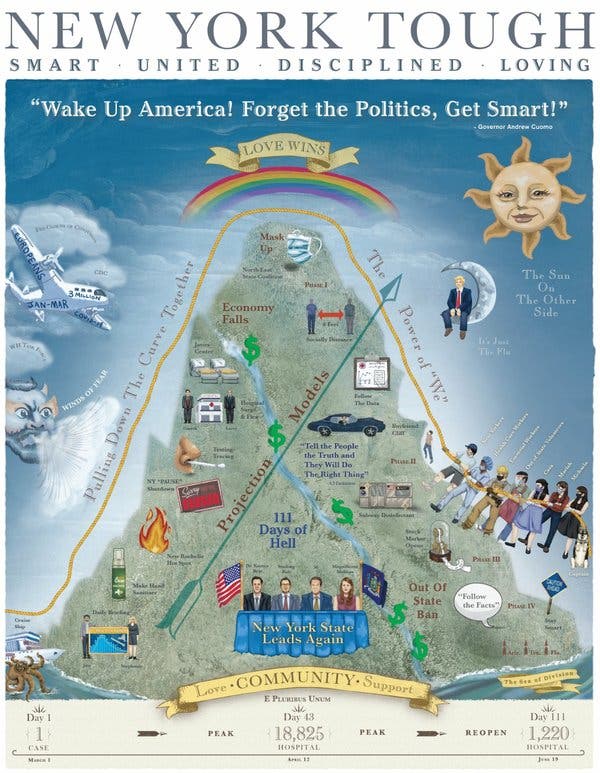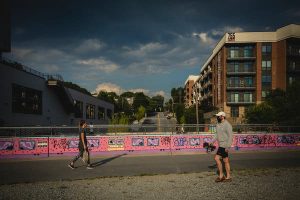Weather: Mixed sun and clouds. High about 80.
Alternate-side parking: Suspended through Sunday. Read about the new amended regulations here.
An octopus is guiding a cruise ship. President Trump is sitting on a crescent moon. But don’t get distracted by that: Beware the Winds of Fear, the incoming plane of Europeans and the Boyfriend Cliff!
We’re not describing a fever dream but Gov. Andrew M. Cuomo’s new “New York Tough” poster, which depicts the hardships of the coronavirus pandemic as a mountain that New Yorkers have climbed. A mask rests on the summit’s peak. Essential workers, and the governor’s daughters and dog, pull “the curve” down.
“What we did was historic because we did tame the beast,” Mr. Cuomo said on Monday as he introduced the retro political poster, his second this year. “We did turn the corner. We did plateau that mountain. And then we came down the other side.”
The internet immediately began picking apart the artwork’s oddly specific details. (Again, Boyfriend Cliff? We and others assumed that the young man dangling from its edge was the partner of one of the daughters.)
A day later in The Times, the art critic Jason Farago devoted 1,100 words to the poster, saying, “Your average TikTok video displays more careful graphic execution than this.”
“As a work of political propaganda,” he conceded, “this poster gets at least one job done: The federal government bears all the blame, the State of New York is diligent and triumphant.”
“New York Tough” came as the state was reporting relatively low numbers of new coronavirus cases, and it echoed Mr. Cuomo’s previous complaints that the federal government did not stop flights from Europe when that continent’s infections were rising.
The poster also throws shade at Arizona, Texas and Florida, three Republican-led states now experiencing record-breaking case counts.
But it doesn’t mention New York’s more than 32,000 coronavirus deaths, a number that towers above those of other states.
State Senator Zellnor Y. Myrie, who like Mr. Cuomo is a Democrat, tweeted: “I mean this with 0% snark: how is this not wildly offensive? This is an artful monument to death and tragedy being sold by the state. I’m legit perplexed.”
The artist behind Mount Coronavirus remained a mystery. In January, the governor had for a third time worked with the Brooklyn artist Rusty Zimmerman to create a poster showing his progressive vision for New York. That image included rocky Steps to Progress emerging from the Sea of Division.
On Twitter this week, Mr. Zimmerman said multiple times that “New York Tough” was not his doing, “though it looks like a few elements were sampled.”
Mr. Cuomo’s office is selling copies of the poster for $11.50 apiece. About 17,300 orders had been placed as of Wednesday afternoon, according to the Rochester Democrat & Chronicle.
The governor appears to have taken a liking to mountain metaphors: Last month, he unveiled a large foam mountain to represent the rise and fall of New York’s virus case count.
“One mountain was enough,” Mr. Cuomo said at the time. But when it comes to art, apparently it wasn’t.
From The Times
N.Y.P.D. Says It Used Restraint During Protests. Here’s What the Videos Show.
Dismemberment Killing of Tech C.E.O. ‘Looks Like Professional Job’
New York City Has 2,300 Parks. But Poor Neighborhoods Lose Out.
Metropolitan Museum of Art to Reopen Five Days a Week in August
Top N.Y.P.D. Chief Injured While Making Arrest at a Protest
Want more news? Check out our full coverage.
The Mini Crossword: Here is today’s puzzle.
What we’re reading
Body-camera footage shows a man being punched and dragged off a subway train by two police officers. [New York Post]
A dead man was found wrapped in plastic on the roof of a McDonalds in the Bronx. [ABC7]
After decades of tension, a Korean-owned beauty supply chain is striking up a partnership with its Black customers and community members. [The City]
And finally: Teenage angst, revisited
When the pandemic hit and her hours at her e-commerce job were cut in half, Chinazor Offor realized she couldn’t sustain living in New York.
Ms. Offor, 25, decided to move home to Georgia at the end of April to ride out the rest of the lockdown with her parents. There, she said, she found herself being less distracted by the hustle and bustle of the city. She had played guitar in high school, and now started practicing regularly.
She also began questioning the financial wisdom of returning to New York.
“I don’t know if I could go back after feeling like I can actually pay off debt,” Ms. Offor said.
A recent Pew Research Center survey found that roughly 20 percent of U.S. adults moved, or know someone who relocated permanently or temporarily, because of the pandemic. The study found that higher income and education played a role in who was able to move.
The Coronavirus Outbreak ›
Frequently Asked Questions
Updated July 15, 2020
-
Is the coronavirus airborne?
- The coronavirus can stay aloft for hours in tiny droplets in stagnant air, infecting people as they inhale, mounting scientific evidence suggests. This risk is highest in crowded indoor spaces with poor ventilation, and may help explain super-spreading events reported in meatpacking plants, churches and restaurants. It’s unclear how often the virus is spread via these tiny droplets, or aerosols, compared with larger droplets that are expelled when a sick person coughs or sneezes, or transmitted through contact with contaminated surfaces, said Linsey Marr, an aerosol expert at Virginia Tech. Aerosols are released even when a person without symptoms exhales, talks or sings, according to Dr. Marr and more than 200 other experts, who have outlined the evidence in an open letter to the World Health Organization.
-
What are the symptoms of coronavirus?
- Common symptoms include fever, a dry cough, fatigue and difficulty breathing or shortness of breath. Some of these symptoms overlap with those of the flu, making detection difficult, but runny noses and stuffy sinuses are less common. The C.D.C. has also added chills, muscle pain, sore throat, headache and a new loss of the sense of taste or smell as symptoms to look out for. Most people fall ill five to seven days after exposure, but symptoms may appear in as few as two days or as many as 14 days.
-
What’s the best material for a mask?
- Scientists around the country have tried to identify everyday materials that do a good job of filtering microscopic particles. In recent tests, HEPA furnace filters scored high, as did vacuum cleaner bags, fabric similar to flannel pajamas and those of 600-count pillowcases. Other materials tested included layered coffee filters and scarves and bandannas. These scored lower, but still captured a small percentage of particles.
-
Is it harder to exercise while wearing a mask?
- A commentary published this month on the website of the British Journal of Sports Medicine points out that covering your face during exercise “comes with issues of potential breathing restriction and discomfort” and requires “balancing benefits versus possible adverse events.” Masks do alter exercise, says Cedric X. Bryant, the president and chief science officer of the American Council on Exercise, a nonprofit organization that funds exercise research and certifies fitness professionals. “In my personal experience,” he says, “heart rates are higher at the same relative intensity when you wear a mask.” Some people also could experience lightheadedness during familiar workouts while masked, says Len Kravitz, a professor of exercise science at the University of New Mexico.
-
I’ve heard about a treatment called dexamethasone. Does it work?
- The steroid, dexamethasone, is the first treatment shown to reduce mortality in severely ill patients, according to scientists in Britain. The drug appears to reduce inflammation caused by the immune system, protecting the tissues. In the study, dexamethasone reduced deaths of patients on ventilators by one-third, and deaths of patients on oxygen by one-fifth.
-
What is pandemic paid leave?
- The coronavirus emergency relief package gives many American workers paid leave if they need to take time off because of the virus. It gives qualified workers two weeks of paid sick leave if they are ill, quarantined or seeking diagnosis or preventive care for coronavirus, or if they are caring for sick family members. It gives 12 weeks of paid leave to people caring for children whose schools are closed or whose child care provider is unavailable because of the coronavirus. It is the first time the United States has had widespread federally mandated paid leave, and includes people who don’t typically get such benefits, like part-time and gig economy workers. But the measure excludes at least half of private-sector workers, including those at the country’s largest employers, and gives small employers significant leeway to deny leave.
-
Does asymptomatic transmission of Covid-19 happen?
- So far, the evidence seems to show it does. A widely cited paper published in April suggests that people are most infectious about two days before the onset of coronavirus symptoms and estimated that 44 percent of new infections were a result of transmission from people who were not yet showing symptoms. Recently, a top expert at the World Health Organization stated that transmission of the coronavirus by people who did not have symptoms was “very rare,” but she later walked back that statement.
-
What’s the risk of catching coronavirus from a surface?
- Touching contaminated objects and then infecting ourselves with the germs is not typically how the virus spreads. But it can happen. A number of studies of flu, rhinovirus, coronavirus and other microbes have shown that respiratory illnesses, including the new coronavirus, can spread by touching contaminated surfaces, particularly in places like day care centers, offices and hospitals. But a long chain of events has to happen for the disease to spread that way. The best way to protect yourself from coronavirus — whether it’s surface transmission or close human contact — is still social distancing, washing your hands, not touching your face and wearing masks.
-
How does blood type influence coronavirus?
- A study by European scientists is the first to document a strong statistical link between genetic variations and Covid-19, the illness caused by the coronavirus. Having Type A blood was linked to a 50 percent increase in the likelihood that a patient would need to get oxygen or to go on a ventilator, according to the new study.
-
How can I protect myself while flying?
- If air travel is unavoidable, there are some steps you can take to protect yourself. Most important: Wash your hands often, and stop touching your face. If possible, choose a window seat. A study from Emory University found that during flu season, the safest place to sit on a plane is by a window, as people sitting in window seats had less contact with potentially sick people. Disinfect hard surfaces. When you get to your seat and your hands are clean, use disinfecting wipes to clean the hard surfaces at your seat like the head and arm rest, the seatbelt buckle, the remote, screen, seat back pocket and the tray table. If the seat is hard and nonporous or leather or pleather, you can wipe that down, too. (Using wipes on upholstered seats could lead to a wet seat and spreading of germs rather than killing them.)
-
What should I do if I feel sick?
- If you’ve been exposed to the coronavirus or think you have, and have a fever or symptoms like a cough or difficulty breathing, call a doctor. They should give you advice on whether you should be tested, how to get tested, and how to seek medical treatment without potentially infecting or exposing others.
Many young New Yorkers returned to their family homes. They slept and worked in the rooms where they grew up.
“Being back here is like a time capsule,” said Sonia Sakhrani, a health care professional who relocated from the Upper East Side to her parents’ home in Forest Hills, Queens.
Ms. Sakhrani, 31, said that while she no longer has a curfew, not having the freedom to go out because of the virus “evokes the same feeling that you had as a teenager.”
Kendall Ciesemier, who drove from Brooklyn to her parents’ home outside of Chicago, said that being thrust back into her childhood environment meant reverting to dynamics she had with her parents growing up.
“The weird thing was having to be like, this is my room, and if the door is closed, you knock,” said Ms. Ciesemier, 27, a producer at a nonprofit.
Reawoken teenage angst and other emotions have resurfaced as people have been going through the closets, boxes and drawers containing treasures from their past.
Jacob Brian Wilson, 34, a publicist from Manhattan, has been sheltering at his parents’ farm in San Miguel, N.M. He said that through certain items, like poetry he had written at age 17, he saw someone he had “lost touch with.”
Tess Koman, 28, an editor from Manhattan, was staying at her parents’ home in New Jersey until recently.
“There is Jewish memorabilia all over the place in my room, menorahs I don’t remember accumulating, books on Jewish teenagerdom I have no recollection of having opened, hamsa necklaces I absolutely never wore,” she said. “And I am 100 percent bringing them all back to my apartment.”
It’s Thursday — #tbt.
Metropolitan Diary: Rockaway Beach
Dear Diary:
I was in the midst of an identity crisis last summer that was brought on by the pressures of graduate school and the looming approach of my 30th birthday.
Trying to reconnect with myself, and perhaps the simpler times of my childhood in Queens, I went to Rockaway Beach with a friend I had known since I was 5.
A nutcracker seller passed by. We called him over to chat and to buy a couple of cold drinks.
As he moved on, he passed a couple with a very young child who were sprawled out next to us.
The nutcracker seller stooped down and shook the child’s hand.
“Welcome to Planet Earth, baby,” he said. “We’re blessed to have you.”
— Kimberly La Porte
New York Today is published weekdays around 6 a.m. Sign up here to get it by email. You can also find it at nytoday.com.
We’re experimenting with the format of New York Today. What would you like to see more (or less) of? Post a comment or email us: [email protected].



















